
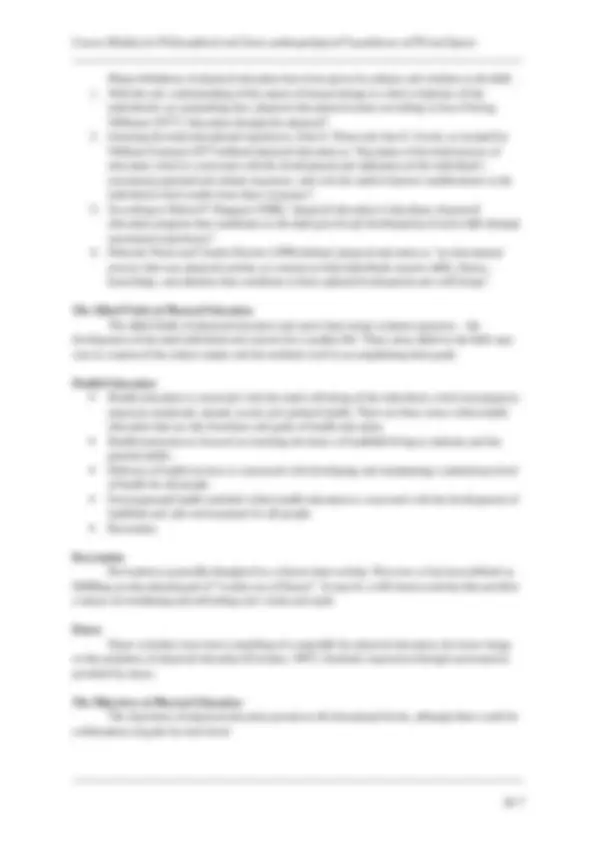
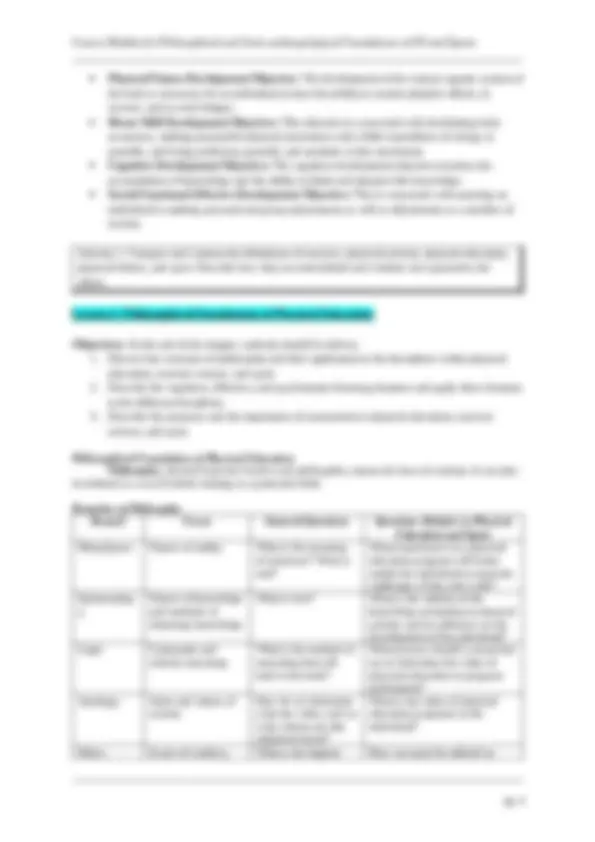
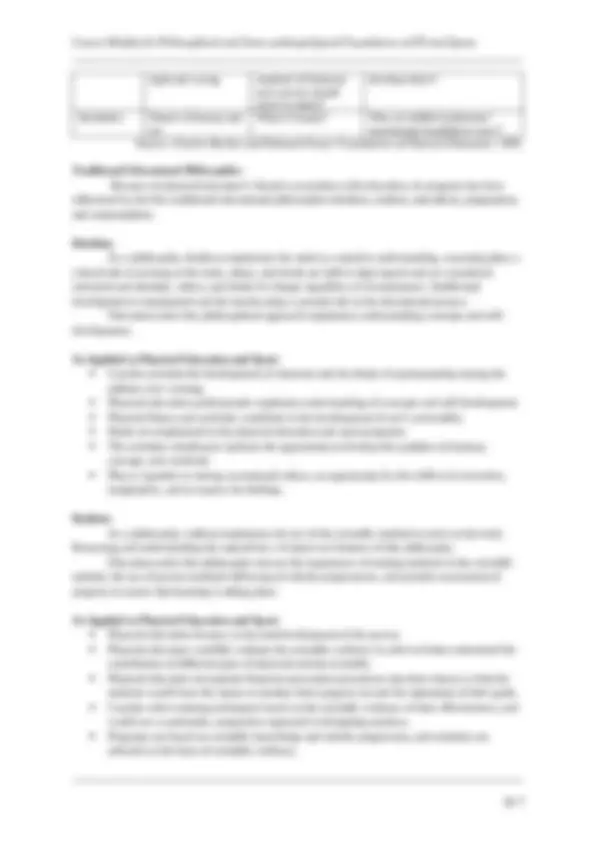

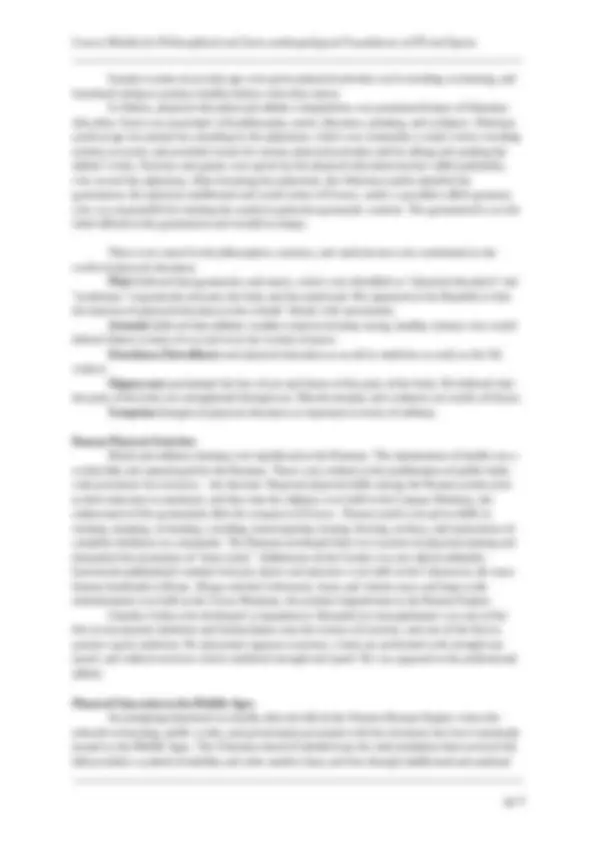
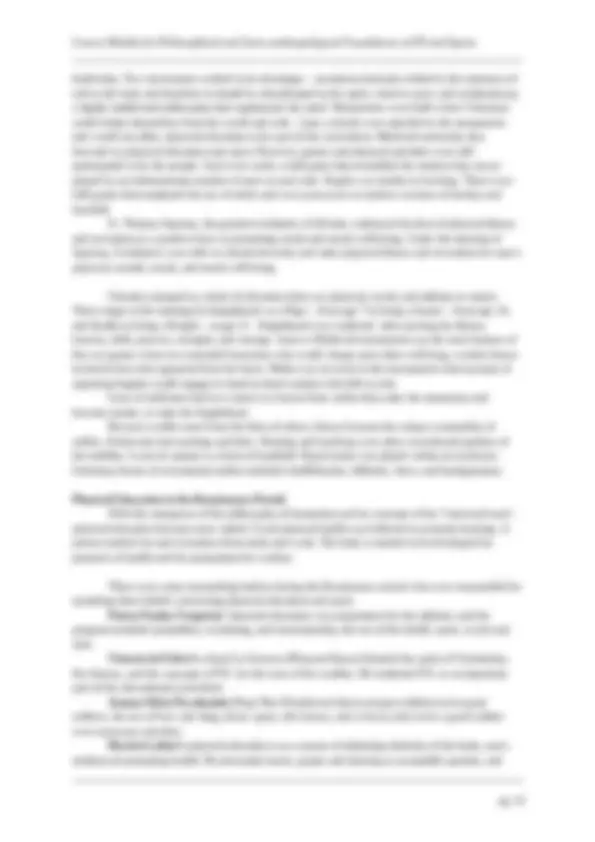
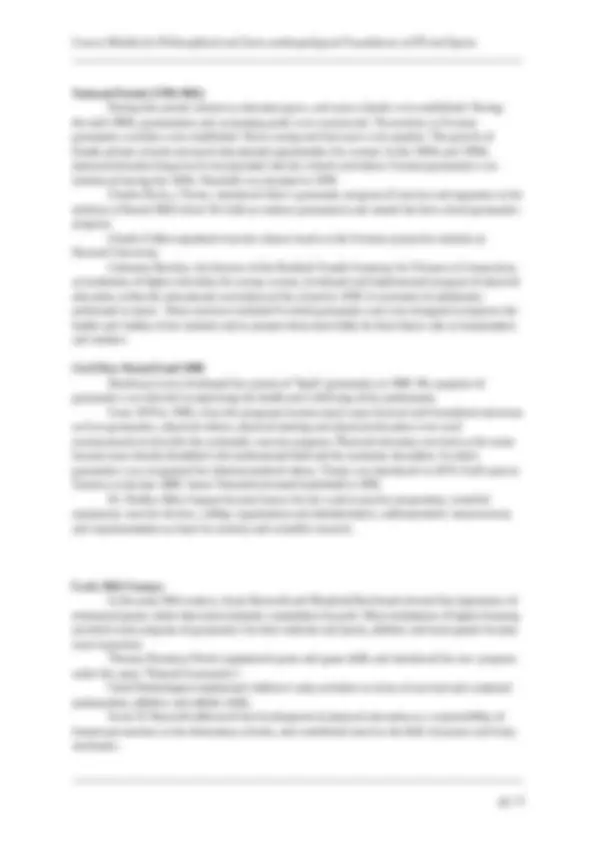
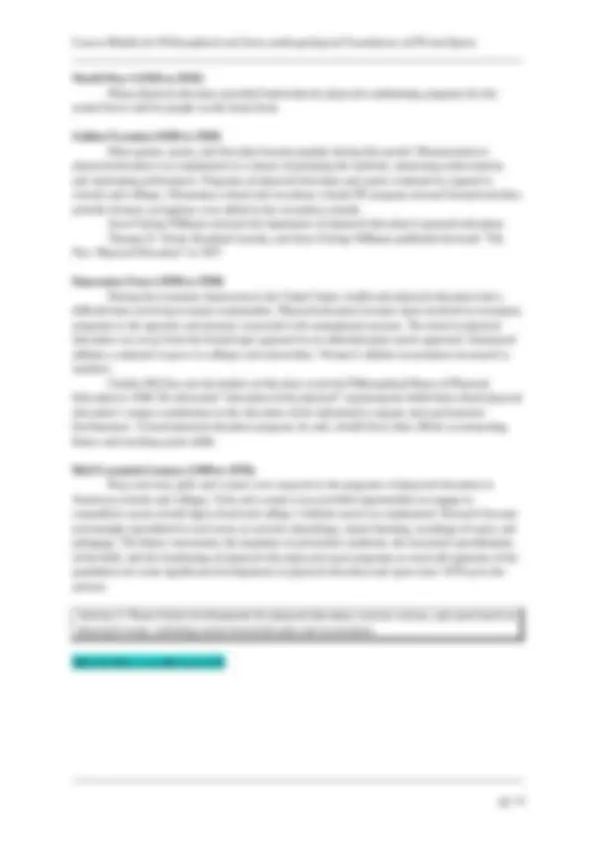

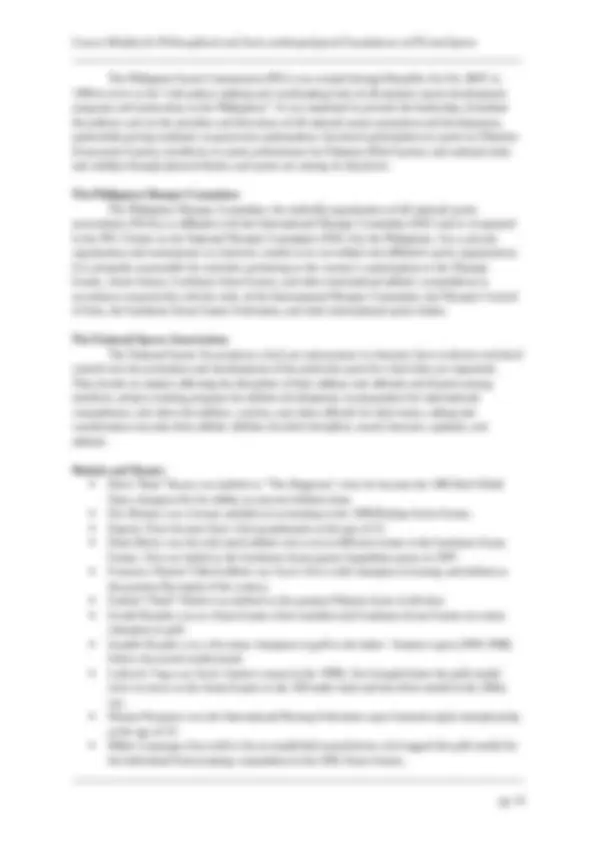
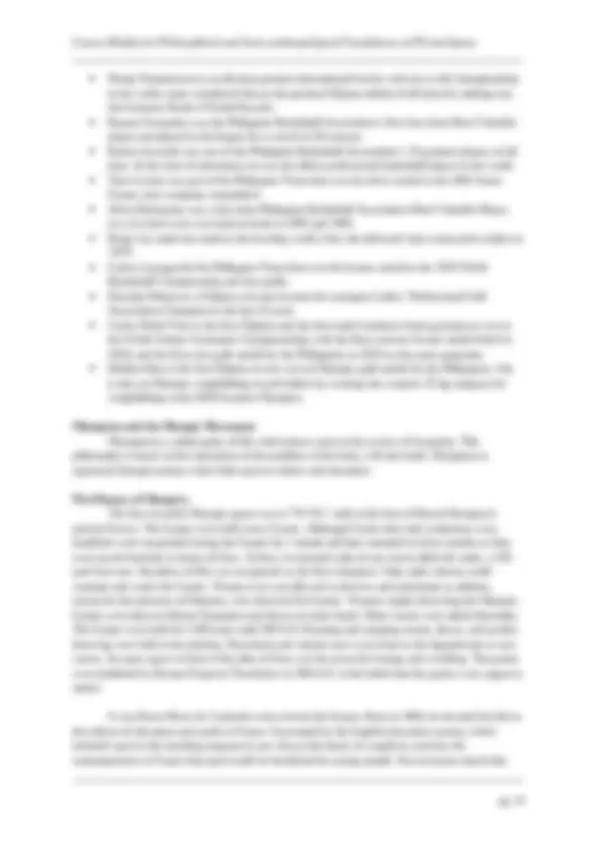
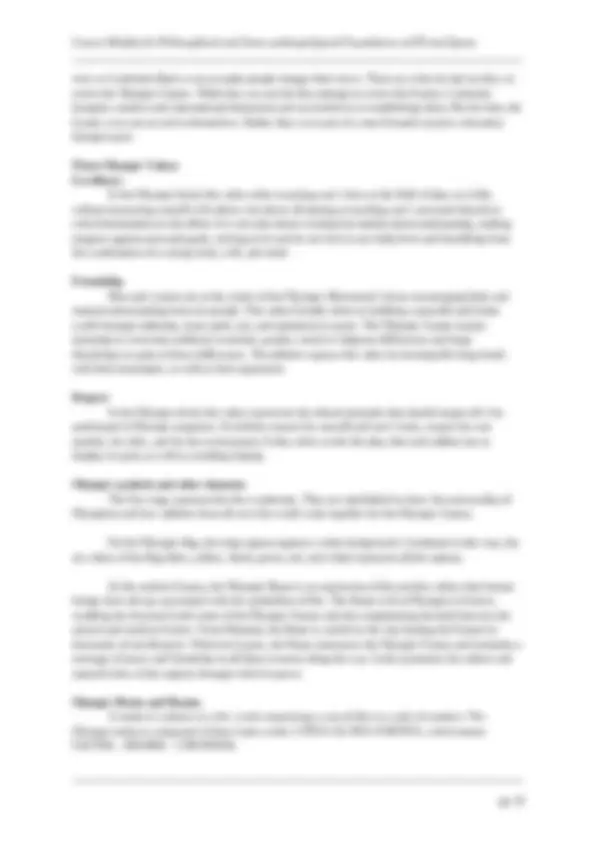

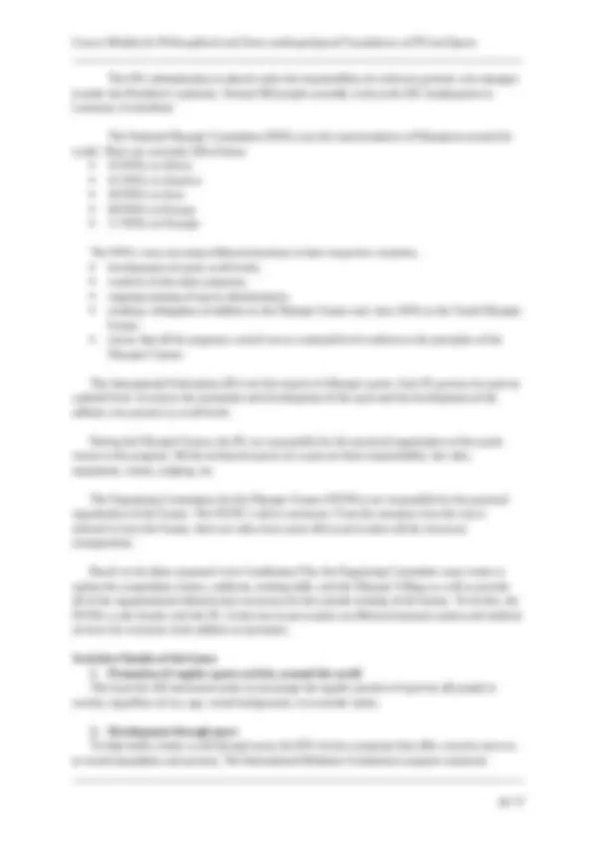
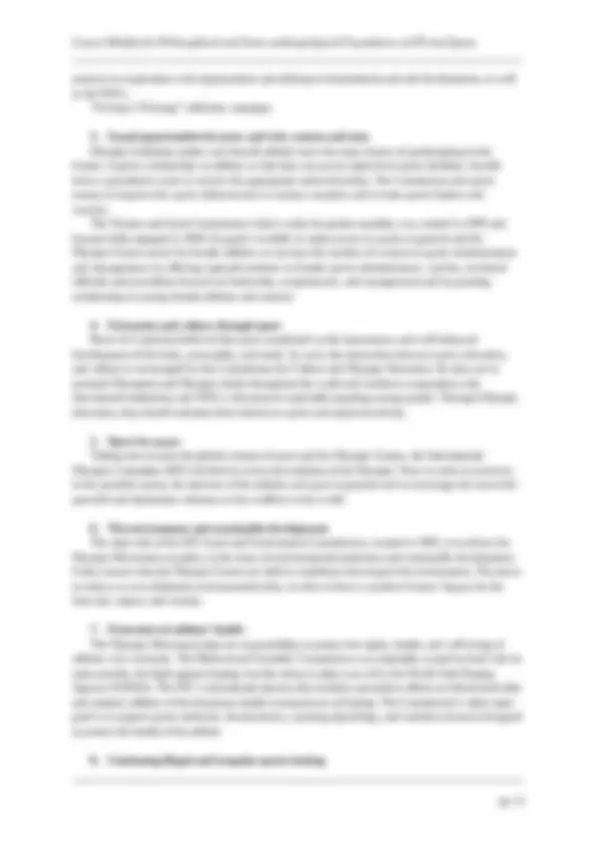
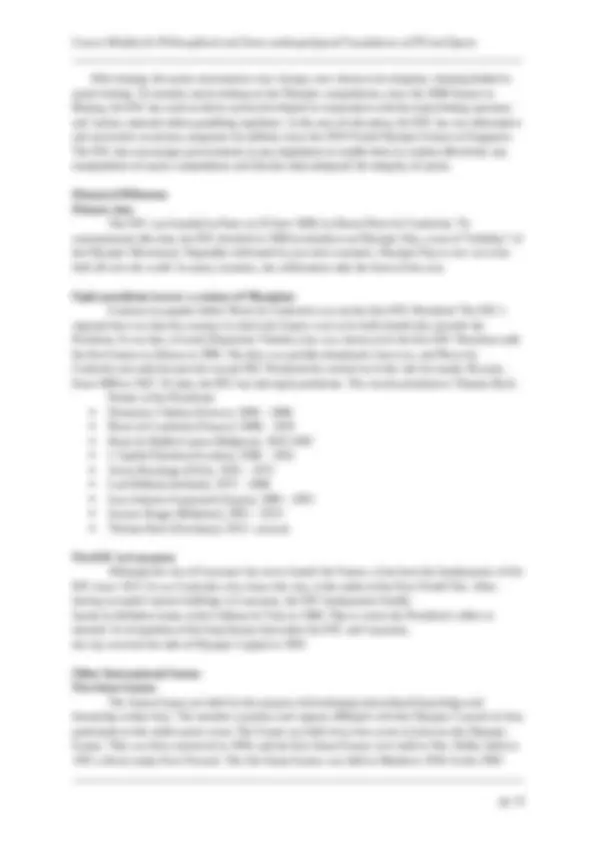
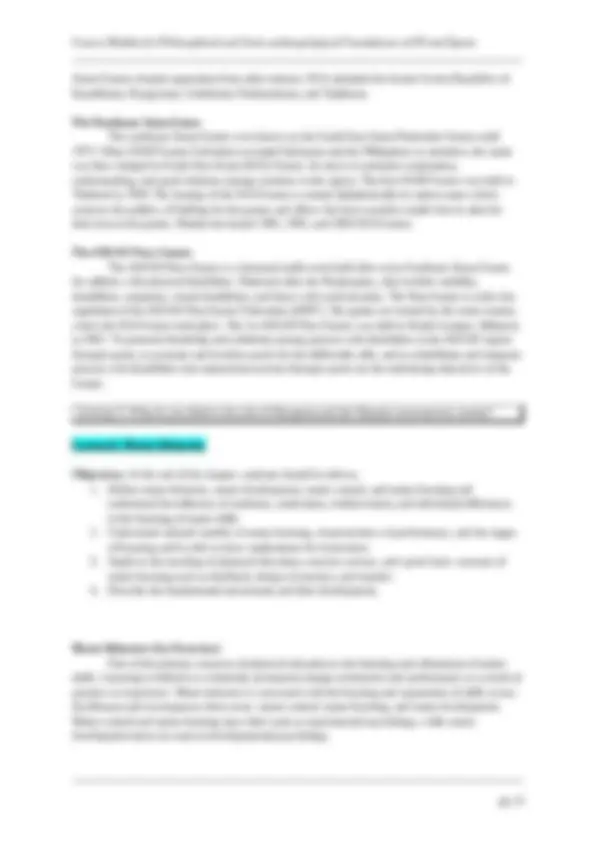
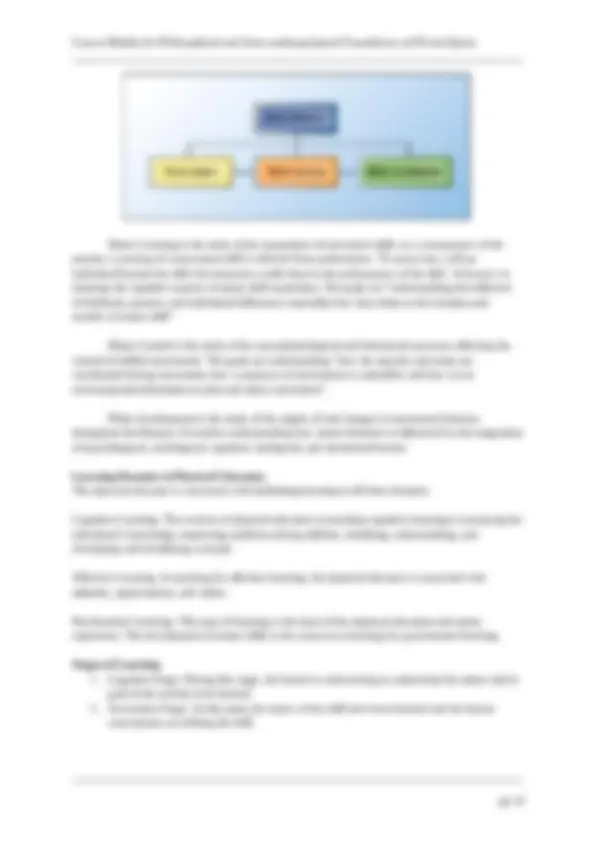
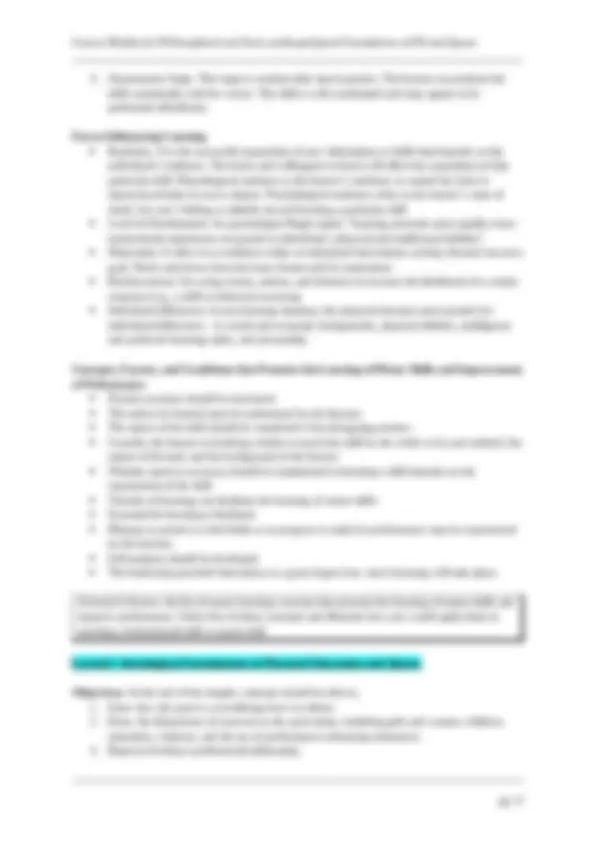
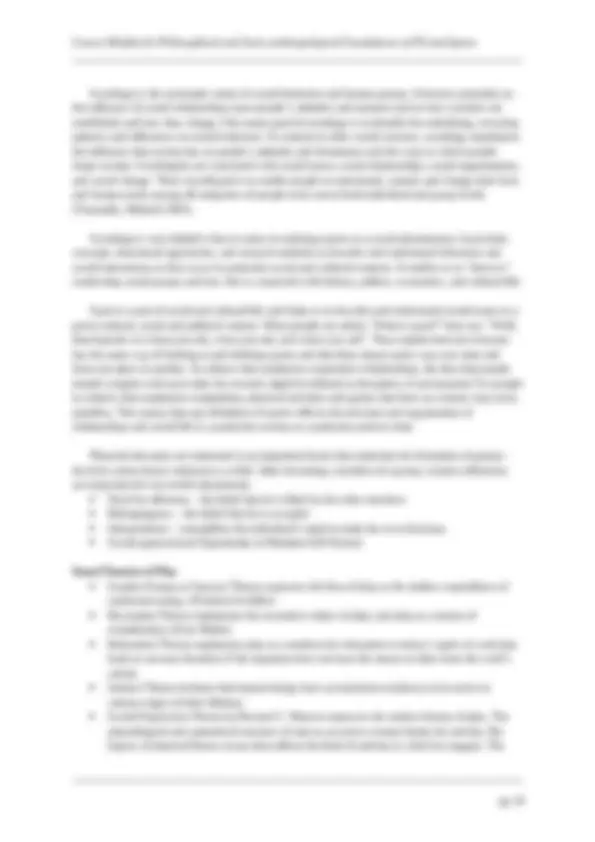
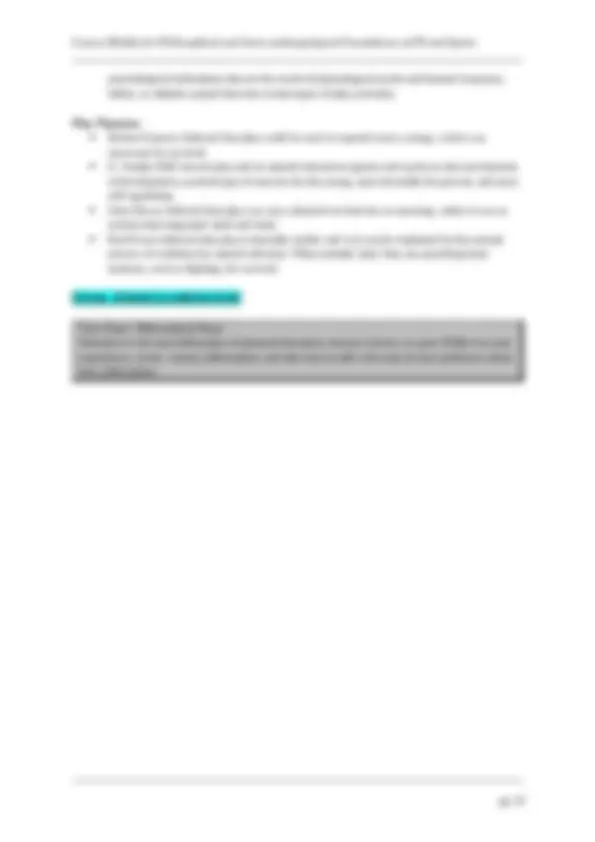


Study with the several resources on Docsity

Earn points by helping other students or get them with a premium plan


Prepare for your exams
Study with the several resources on Docsity

Earn points to download
Earn points by helping other students or get them with a premium plan
Community
Ask the community for help and clear up your study doubts
Discover the best universities in your country according to Docsity users
Free resources
Download our free guides on studying techniques, anxiety management strategies, and thesis advice from Docsity tutors
This is a course module for Philosophical & Socio anthropological Foundations of PE & Sports.
Typology: Lecture notes
1 / 29

This page cannot be seen from the preview
Don't miss anything!






















Course Title: Philosophical and Socio-anthropological Foundations of PE and Sports Course Description: A study of the diverse justifications on the educational value of PE and an examination how the various structures, patterns, organizations, and institutions in culture and society create, relate to, and influence physical education and sports; discussion of the historic tradition of mind/ body and theoretical/ practical knowledge dualism; conceptual analysis of the issues of sports as a human activity and the distinction and relationship between PE and sport. Course Credit: 3 units Contact Hours: 3 hours Prerequisite: Instructor: Consultation Time: Program Specialization Outcomes: On successful completion of this course students should be able to: Provide information about the nature, concepts, and objectives of physical education. Identify the influences of the various philosophies on physical education. Trace the historical development of physical education. Identify the philosophical, psychological, and sociological theories of physical education. Apply the theories and principles in the teaching of physical education. Relate the theories and principles to the teaching of physical education. Suggested Learning Resources (e.g., Textbooks and References)
Objectives: At the end of the chapter, students should be able to;
Physical Fitness Development Objective: The development of the various organic system of the body is necessary for an individual to have the ability to sustain adaptive efforts, to recover, and to resist fatigue. Motor Skill Development Objective: This objective is concerned with developing body awareness, making purposeful physical movement with a little expenditure of energy as possible, and being proficient, graceful, and aesthetic in this movement. Cognitive Development Objective: The cognitive development objective involves the accumulation of knowledge and the ability to think and interpret this knowledge. Social-Emotional-Affective Development Objective: This is concerned with assisting an individual in making personal and group adjustments as well as adjustments as a member of society. Activity 1: Compare and contrast the definitions of exercise, physical activity, physical education, physical fitness, and sport. Describe how they are interrelated and whether one supersedes the others.
Objectives: At the end of the chapter, students should be able to;
right and wrong standard of behavior each person should strive to attain? develop ethics? Aesthetics Nature of beauty and art What is beauty? Why are skilled performers’ movements beautiful to view? Source: Charles Bucher and Deborah Wuest. Foundations of Physical Education. 1995. Traditional Educational Philosophies Because of physical education’s historic association with education, its program has been influenced by the five traditional educational philosophies-idealism, realism, naturalism, pragmatism, and existentialism. Idealism As a philosophy, idealism emphasizes the mind as central to understanding, reasoning plays a critical role in arriving at the truth, values, and ideals are held in high regard and are considered universal and absolute, values, and ideals do change regardless of circumstances. Intellectual development is emphasized and the teacher plays a pivotal role in the educational process. Education under this philosophical approach emphasizes understanding concepts and self- development. As Applied to Physical Education and Sport Coaches promote the development of character and the ideals of sportsmanship among the athletes over winning. Physical education professionals emphasize understanding of concepts and self-development. Physical fitness and activities contribute to the development of one’s personality. Ideals are emphasized in the physical education and sport programs. The activities should give students the opportunity to develop the qualities of honesty, courage, and creativity. Play is regarded as having recreational values, an opportunity for the child to be inventive, imaginative, and to express his feelings. Realism As a philosophy, realism emphasizes the use of the scientific method to arrive at the truth. Reasoning and understanding the natural laws of nature are features of this philosophy. Education under this philosophy stresses the importance of training students in the scientific method, the use of proven methods following of orderly progressions, and periodic assessment of progress to ensure that learning is taking place. As Applied to Physical Education and Sport Physical education focuses on the total development of the person. Physical educators carefully evaluate the scientific evidence in order to better understand the contribution of different types of physical activity to health. Physical educators incorporate frequent assessment procedures into their classes so that the students would have the means to monitor their progress toward the attainment of their goals. Coaches select training techniques based on the scientific evidence of their effectiveness, and would use a systematic, progressive approach in designing practices. Programs are based on scientific knowledge and orderly progression, and activities are selected on the basis of scientific evidence.
As Applied to Physical Education and Sport A sports psychologist encourages an athlete to carefully reflect upon his experiences in order to identify the thoughts that led to poor performances. He offers the athlete variety of options to deal with these issues, allowing the athlete to choose among the alternatives. An existentialist coach emphasizes the athlete’s responsibility in adhering to the established code of conduct. He allows some individuality in dress but emphasizes the athlete’s responsibility in adhering to training rules. Physical educators allow students to select from a variety of activities within the program, promoting reflection, and individual responsibility for learning. Physical educators emphasize the importance of creativity. The activities provide the students with opportunities to develop self-awareness and self- responsibility. The teacher is a counselor who promotes reflective thinking while allowing the students to make choices and deal responsibly with the consequences of those choices. Activity 2: Of the six major philosophies, which one do you identify with the most? Why do you identify with this philosophy? How do you think your philosophical perspective can impact you as a future professional?
Physical activities in the primitive society Physical education in the ancient nation Physical education and sport in Greece and Rome Physical Education in the Middle Ages Physical Education in the Renaissance Period Physical Education in Europe Physical Education in the United States Objectives: At the end of the chapter, students should be able to;
Participation in physical activities in primitive society was practical. The strong, agile, and powerful bodies were necessary to carry on the demands of primitive life. Mimetic games provided children the opportunity to prepare themselves for adult life and responsibilities. Through dancing, primitive people communicated to their gods. Physical Education in the Ancient Nation Persia: Physical education was the modality used to accomplish the primary aim of developing in their young men military skills, high moral standards, and patriotism to strengthen and extend the empire. Egypt: Popular activities in ancient Egypt were swimming, since civilization’s life was based on rivers. Wrestling which was participated in by the nobility, the soldiers, the merchants, and the unskilled laborers; and gymnastic activities and games using the skills of fighting and war. Gymnastics exercises were required exercises to make the body supple, strong, and capable of great endurance and stamina. One of the most popular indoor activities was a board game called senet. Dances were both religious and folk. China: Physical activities in ancient China were confined to the military men. They were given examinations on lifting the weights, shooting the bow, and handling the sword. They boxed, played football (tsu’ u chu), and practiced jiu-jitsu. Recreational games and sports such as the early versions of soccer, polo, chess, and competitions in archery and wrestling, tug-of –war, water games, chi’ ui wan (similar to golf), shuttlecock, and kite flying were popular. Dancing was popular that a man’s prestige often depended on his prowess as a dancer. When ancient Chinese felt weak, Cong Fu, a mild exercises, similar to gymnastics-oriented calisthenics and developed in 2698 B.C was designed to prevent diseases and keep the body in good organic conditions. India: Several physical activities were participated in by ancient India despite Buddha’s prohibition of games, amusements, and exercises. Throwing balls, plowing contests, tumbling, chariot races, riding elephants and horse, swordsmanship, wrestling, and boxing were among their favorites. Became very popular in India was Yoga, which was a unique activity involving exercises in posture, regulated breathing, to discipline the mind and the body. Physical exercises were sometimes used to promote health. Hindu dancing was considered the oldest of organized dancing. Physical Education and Sport in Greece Physical education was a vital part of the education of every Greek boy. Gymnastics was believed to contribute to courage, discipline, and physical well-being. It stressed a sense of fair play, development of the individual’s aesthetic values, amateurism, and the utilitarian values inherent in the activity. Greek sport manifested itself in the concept of the amateur athlete, whose primary goal is to compete in a “circuit” of four major national festivals- the Olympia Festival, the Pythia Festival, the Nemea festival, and the Isthmia Festival that were designated as the Pan-Hellenic Festival, and scheduled to ensure that one major competition was held every year. The Spartan approach to physical training (not physical education) was strictly the training of the body for military purposes. The Spartan boy at seven years of age is housed in a primitive barracks under the watchful eye of the Paidonomous, who supervised the educational program called the Agoge. Instructions in swimming, running, fighting, wrestling, boxing, ball games, horsemanship, archery, discus and javelin throwing, field marches, and pancratium, a combination of boxing and wrestling were given. At age twenty (20), he took an oath of allegiance to Sparta and went into actual combat where they engaged themselves in intensive military maneuvers and warfare until the age of fifty (50). A well-educated Spartan was one who was physically fit and a good soldier.
leadership. Two movements worked to its advantage – asceticism that had a belief in the existence of evil in the body and therefore it should be subordinated to the spirit, which is pure; and scholasticism, a highly intellectual philosophy that emphasized the mind. Monasteries were built where Christians could isolate themselves from the world and evils. Later, schools were attached to the monasteries and would not allow physical education to be part of the curriculum. Medieval university also frowned on physical education and sport. However, games and physical activities were still participated in by the people. Such were soule, a ball game that resembled the modern-day soccer played by an indeterminate number of men on each side. Kegels was similar to bowling. There were ball games that employed the use of sticks and were precursors to modern versions of hockey and baseball. St. Thomas Aquinas, the greatest scholastic of all time, embraced the idea of physical fitness and recreation as a positive force in promoting social and moral well-being. Under the tutoring of Aquinas, Scholastics were able to cherish the body and value physical fitness and recreation for man’s physical, mental, social, and moral well-being. Chivalry emerged as a kind of education that was physical, social, and military in nature. Three stages in the training for knighthood: as a Page – from age 7 to being a Squire – from age 14, and finally to being a Knight – at age 21. Knighthood was conferred after proving his fitness, bravery, skill, prowess, strength, and courage. Joust or Medieval tournament was the most famous of the war games where two mounted horsemen who would charge each other with long, wooden lances to knock down the opponent from his horse. Melee was an event in the tournament where groups of opposing knights would engage in hand-to-hand combat with dull swords. Sons of noblemen had two careers to choose from: either they enter the monastery and become monks, or enter the knighthood. Because wealth came from the labor of others, leisure became the unique commodity of nobles. Aristocrats had sporting activities. Hunting and hawking were other recreational pastime of the nobility. Le jeu de paume is a form of handball. Royal tennis was played within an enclosure. Sedentary forms of recreational outlets included shuffleboards, billiards, chess, and backgammon. Physical Education in the Renaissance Period With the emergence of the philosophy of humanism and its concepts of the “universal man”, physical education became more valued. Good physical health was believed to promote learning. A person needed rest and recreation from study and work. The body is needed to be developed for purposes of health and for preparation for warfare. There were some outstanding leaders during the Renaissance period who were responsible for spreading these beliefs concerning physical education and sport. Petrus Paulus Vergerius’ physical education was preparation for the military, and his program included pentathlon, swimming, and horsemanship, the use of the shield, spear, sword and club. Vittorio da Feltre’s school La Giocosa (Pleasant House) blended the spirit of Christianity, the classics, and the concepts of P.E. for the sons of the wealthy. He instituted P.E. as an important part of the educational curriculum. Aeneas Silvio Piccolomini (Pope Pius II) believed that to prepare children to be good soldiers, the use of bow and sling, throw spear, ride horses, and swim in order to be a good soldier were necessary activities. Martin Luther’s physical education was a means of obtaining elasticity of the body, and a medium of promoting health. He advocated music, games and dancing as acceptable pastime, and
believed that people should engage in honorable and useful modes of exercises so they would not fall into vice and evil pursuits during leisure hours. Thomas Elyot’s being familiar with the latest medical teachings of his time, he claimed six (6) physiological benefits that could be derived from exercise: aids in digestion, increases appetite, helps in living longer, warms the body, raises metabolism, and cleanses the body of its wastes. Roger Ascham appreciated the value of exercise as a means of resting the mind to make it sharper at a later time. Francois Rabelais believed that physical activities help the students reach his goal of being a well-rounded individual and these include horsemanship, martial arts, hunting, and ball playing, running, and swimming. Richard Mulcaster’s book Positions dealt specifically to physical education: for indoors, he recommended dancing, wrestling, fencing, and climbing; for outdoors, walking, running, leaping, swimming, riding, hunting, shooting, and playing ball. He was considered the “father” of the modern educational practice including sports in the schools. Michel de Montaigne advocated “manly exercise” where the child experienced the rougher life in the outdoors. John Comenius believed that exercise served as a rest from other parts of the learning process, and P.E. exists to refresh the body and able one to work and study more efficiently. John Milton believed that martial arts should be practiced in schools, because they were useful in time of war. John Locke believed that P.E. was of primary importance in developing an educational foundation because physical activity is used to refresh the individual in order to pursue more intellectual pursuits. The development of the child’s health was Jean Jacques Rousseau’s first requirement in the education of the child. He believed that children should develop their senses through specific physical activities, such as swimming, running, jumping, spinning a top, throwing stones, etc. Physical Education in Europe Germany Johann Bernhard Basedow founded the Philanthropinum in 1774, where three hours of the ten-hour school day was to be spent for recreational activities such as fencing, riding, dancing, and music. His younger students engaged in “Greek Gymnastics” contests: running, wrestling, throwing, and jumping; older ones practiced “knightly exercises” as dancing, fencing, riding, vaulting on live horses, shuttlecock, tennis, skittles, and playing with large air-filled ball. Johann Christoph Friedrich Gutsmuths who is considered the real founder of physical education, and “grandfather of physical education” legitimized the P.E. profession and believed in the promotion of people’s health to have a strong nation Friedrich Wilhelm August Froebel established the theory of play and believed that play in the form of physical education was a wonderful mechanism for stress reduction, and character and moral development. Friedrich Ludwig Jahn whose system of gymnastics was more political in nature established the German Turnverein Movement in the spring of 1811. He was called turnvater – father of gymnastics. The word was coined from the extinct Teutonic word – turnen – to perform gymnastics exercises. Adolph Spiess believed that the P.E. program should be progressive that is, from simple exercises to more difficult. and advocated exercises combined with music for free expression, and believed in marching exercises as aid in class organization, discipline, and posture development.
National Period (1784-1861) During this period, interest in education grew, and more schools were established. During the mid-1800s, gymnasiums and swimming pools were constructed. Turnvereins or German gymnastics societies were established. Horse racing and foot races were popular. The growth of female private schools increased educational opportunities for women. In the 1820s and 1830s, physical education began to be incorporated into the school curriculum. German gymnastics was introduced during the 1820s. Baseball was invented in 1839. Charles Beck, a Turner, introduced Jahn’s gymnastic program of exercise and apparatus to his students at Round Hill School. He built an outdoor gymnasium and started the first school gymnastics program. Charles Follen organized exercise classes based on the German system for students at Harvard University. Catharine Beecher, the director of the Hartford Female Seminary for Women in Connecticut, an institution of higher education for young women, developed and implemented program of physical education within the educational curriculum of the school in 1828. It consisted of calisthenics performed to music. These exercises included Swedish gymnastics and were designed to improve the health and vitality of her students and to prepare them more fully for their future role as homemakers and mothers. Civil War Period Until 1900 Dioclesan Lewis developed his system of “light” gymnastics in 1860. His program of gymnastics was directed at improving the health and well-being of his participants. From 1870 to 1900, when the programs became much more focused and formalized and terms such as gymnastics, physical culture, physical training and physical education were used synonymously to describe the systematic exercise program. Physical education survived as the name became most closely identified with professional field and the academic discipline. Swedish gymnastics was recognized for inherent medical values. Tennis was introduced in 1874. Golf came to America in the late 1880. James Naismith invented basketball in 1895. Dr. Dudley Allen Sargent became known for his work in teacher preparation, remedial equipment, exercise devices, college organization and administration, anthropometric measurement, and experimentation as basis for activity and scientific research. Early 20th Century In the early 20th century, Jessie Bancroft and Elizabeth Burchenal stressed the importance of intramural games rather than interscholastic competition for girls. Most institutions of higher learning provided some program of gymnastics for their students and sports, athletics and team games became more important. Thomas Dennison Wood emphasized game and game skills and introduced his new program under the name “Natural Gymnastics”. Clark Hetherington emphasized children’s play activities in terms of survival and continued participation, athletics and athletic skills. Jessie H. Bancroft influenced the development of physical education as a responsibility of homeroom teachers in the elementary schools, and contributed much to the field of posture and body mechanics.
World War I (1916 to 1919) Many physical educators provided leadership for physical conditioning programs for the armed forces and for people on the home front. Golden Twenties (1920 to 1929) More games, sports, and free play became popular during this period. Measurement in physical education was emphasized as a means of grouping the students, measuring achievements, and motivating performance. Programs of physical education and sports continued to expand in schools and colleges. Elementary school and secondary schools PE program stressed formal activities; periodic lectures on hygiene were added in the secondary schools. Jesse Feiring Williams stressed the importance of physical education in general education. Thomas D. Wood, Rosalind Cassidy, and Jesse Feiring Williams published the book “The New Physical Education” in 1927. Depression Years (1930 to 1939) During the economic depression in the United States, health and physical education had a difficult time surviving in many communities. Physical educators became more involved in recreation programs in the agencies and projects concerned with unemployed persons. The trend in physical education was away from the formal-type approach to an informal game-sports approach. Intramural athletics continued to grow in colleges and universities. Women’s athletic associations increased in numbers. Charles McCloy one the leaders of this time wrote the Philosophical Bases of Physical Education in 1940. He advocated “education of the physical” espousing the belief that school physical education’s unique contribution to the education of the individual is organic and psychomotor development. School physical education program, he said, should focus their efforts on promoting fitness and teaching sports skills. Mid-Twentieth Century (1940 to 1970). Boys and men, girls and women were exposed to the programs of physical education in American schools and colleges. Girls and women were provided opportunities to engage in competitive sports at both high school and college. Lifetime sport was emphasized. Research became increasingly specialized in such areas as exercise physiology, motor learning, sociology of sport, and pedagogy. The fitness movement, the emphasis on preventive medicine, the increased specialization of the field, and the broadening of physical education and sport programs to reach all segments of the population are some significant developments in physical education and sport since 1970 up to the present. Activity 3: Project future developments for physical education, exercise science, and sport based on historical events, including events from both early and recent times.
1911 – The “Athletic Handbook” was published by the Bureau of Education where the first part prescribed a few simple games and relays; the second part contained the rules for baseball, basketball for girls, volleyball, indoor baseball, track and field, and lawn tennis. January 1911 - the Philippine Amateur Athletic Federation (PAAF) was organized to control amateur sports in the Philippines. 1914 – In cognizant of the implementation of the “play for everybody” policy of the Bureau of Education, the Teacher’s Vacation Assembly started in Manila to give special training to Filipino teachers to be able to conduct various physical activities, and in turn recipients of the special training taught at the provincial normal schools March 5, 1919 – A syllabus entitled “Physical education: A Manual for Teachers” was published as a result of the plan in 1918 for a definite course of study in Physical Education, submitted by a special committee of superintendents. 1920 – Physical Education was made a required subject in all public schools. A rating of 75% which was based on attendance in the required exercises is necessary for promotion every year from grade four to fourth-year high school. However, the grade was not included in the computation of the general average. 1928 – A Summer School for Coaching was opened by the Office of the National Physical Education Director in cooperation with the Bureau of Education to help the public school teachers who are in charge of athletics to improve their coaching methods. 1937 – Physical Education was made a curricular subject in the secondary schools where the grade was not only based on attendance but on proficiency in skills as well. The grade was included in the computation of the general average. 1939 – Women’s track and field was added to the program of the National Inter-Scholastics. Japanese Period The Japanese Military Administration obliged all public schools to perform daily calisthenics on air called the Radio Taiso, where Japanese instructors were provided. The demonstration of the exercise was held in Luneta. Post-War to Present 1948 to 1952 – Under the joint sponsorship of the PAAF and Department of Education, The National College of Physical Education conducted a Summer school of Physical Education held at the Rizal Memorial Field. In 1953, PAAF took the sponsorship alone. The Schools Physical Education and Sports Act of 1969 provided a program of activities that included among others a program of health education and nutrition, a program of physical fitness for all pupils, a program of competitive athletics, a program of intramural and inter- unit athletic competition within schools, districts, and provinces, and an annual competition within and among regions. In the 70’s and early 80’s, physical education was incorporated in the subject Youth Development Training or YDT in high school. The subjects included Physical Education, Scouting, Health, and Music. The Physical Education Program in the Elementary was revised in 1971 to comprise the activities such as the Testing Program, rhythmic activities, games, relays and athletic team games, swimming, and physical education for children needing attention. The Revised Secondary School Program is contained in Department Order No. 20, s. 1973. Two aspects of the program were Youth Development Training (YDT) for the first year to the third year and Citizen Army Training (CAT) for fourth-year high school.
In MEC Order No. 6, s. 1982, the New Elementary School Curriculum (NESC) reflected directions for change based on the Program for Decentralized Educational Development (PRODED). PE in Grades I and II is integrated with the subject Sibika at Kultura (Civics and Culture). No specific time block is allotted to this subject but is taught as the need arises. Grades III to VI PE is clustered with Art and Music in a subject entitled Music, Art, and Physical Education (MAPE). The 1989 Secondary Education Development Program (SEDP) is a response to continue pupil development started by the Program for Decentralized Educational Development in 1982. Based on DECS Order No. 11, s. 1989, the New Secondary Education Curriculum (NSEC) of SEDP is cognitive-affective-manipulative-based and is student-centered and community- oriented. One of the 8 subject areas in the NSEC is Physical Education, Health and Music (PEHM). In the elementary, based on DECS Order No. 53, s. 1994, states that Physical Education in Grades I and II shall be listed as a separate additional subject and will be taught daily for 20 minutes beginning school year 1994 – 1995 in public elementary schools. It shall continue to be taught as a component of MAPE in Grades III to VI. Activity 4: Learning the history of PE and sports in the country, elaborate your thoughts on the questions below; Why do you think “PE lang” ideology is seen in today’s Philippine education system? Why is The Philippines relatively “weak” in sports?
Objectives: At the end of the chapter, students should be able to;
Paeng Nepomuceno is an all-time greatest international bowler with six world championships to his credit; some considered him as the greatest Filipino athlete of all time for making it to the Guinness Book of World Records. Ramon Fernandez was the Philippine Basketball Association’s first four-time Most Valuable player and played in the league for a record of 20 seasons. Robert Jaworski was one of the Philippine Basketball Association’s 25 greatest players of all time. At his time of retirement, he was the oldest professional basketball player in the world. Toni Leviste was part of the Philippine Team that won the silver medal in the 2002 Asian Games show jumping competition. Alvin Patrimonio was a four-time Philippine Basketball Association Most Valuable Player, two of which were won back-to-back in 1993 and 1994. Bong Coo made her mark in the bowling world when she delivered nine consecutive strikes in
Carlos Loyzaga led the Philippine Team that won the bronze medal in the 1954 World Basketball Championship and four golds. Dorothy Delasin is a Filipina who has become the youngest Ladies’ Professional Golf Association Champion in the last 25 years. Carlos Edriel Yulo is the first Filipino and the first male Southeast Asian gymnast to win in the World Artistic Gymnastic Championships with his floor exercise bronze medal finish in 2018, and the first-ever gold medal for the Philippines in 2019 on the same apparatus. Hidilyn Diaz is the first Filipina to ever win an Olympic gold medal for the Philippines. She is also an Olympic weightlifting record-holder by winning the women's 55 kg category for weightlifting at the 2020 Summer Olympics. Olympism and the Olympic Movement Olympism is a philosophy of life which places sport at the service of humanity. This philosophy is based on the interaction of the qualities of the body, will and mind. Olympism is expressed through actions which link sport to culture and education. The History of Olympics The first recorded Olympic game was in 776 B.C. held at the foot of Mount Olympia in ancient Greece. The Games were held every 4 years. Although Greek cities had continuous wars, hostilities were suspended during the Games for 1 month and later extended to three months as they were sacred festivals in honor of Zeus. At first, it consisted only of one event called the stade, a 192- yard foot race. Koroibus of Elis was recognized as the first champion. Only male citizens could compete and watch the Games. Women were not allowed to observe and participate as athletes, except for the priestess of Demeter, who observed the Games. Women caught observing the Olympic Games were taken to Mount Tympaion and thrown to their death. Other events were added thereafter. The Games were held for 1169 years until 393 A.D. Running and jumping events, discus, and javelin throwing were held at the stadium. Horseback and chariot races were done in the hippodrome or race course. An open space in front of the altar of Zeus was the arena for boxing and wrestling. The games were abolished by Roman Emperor Theodosius in 394 A.D. in the belief that the games were pagan in nature. It was Baron Pierre de Coubertin who revived the Games. Born in 1863, he devoted his life to the reform of education and youth in France. Fascinated by the English education system, which included sport in the teaching program (a new idea at the time), he sought to convince his contemporaries in France that sport could be beneficial for young people. Not everyone shared this
view so Coubertin liked a way to make people change their views. That was when he had an idea: to revive the Olympic Games. While this was not the first attempt to revive the Games, Coubertin brought a modern and international dimension and succeeded in re-establishing them. But for him, the Games were not an end in themselves. Rather they were part of a much broader project: education through sport. Three Olympic Values Excellence In the Olympic ideal, this value refers to giving one’s best on the field of play or in life, without measuring oneself with others, but above all aiming at reaching one’s personal objectives with determination in the effort. It is not only about winning but mainly about participating, making progress against personal goals, striving to be and do our best in our daily lives and benefiting from the combination of a strong body, will, and mind. Friendship Men and women are at the center of the Olympic Movement’s focus encouraging links and mutual understanding between people. This value broadly refers to building a peaceful and better world through solidarity, team spirit, joy, and optimism in sports. The Olympic Games inspire humanity to overcome political, economic, gender, racial or religious differences and forge friendships in spite of those differences. The athletes express this value by forming life-long bonds with their teammates, as well as their opponents. Respect In the Olympic ideal, this value represents the ethical principle that should inspire all who participate in Olympic programs. It includes respect for oneself and one’s body, respect for one another, for rules, and for the environment. It thus refers to the fair play that each athlete has to display in sport, as well as avoiding doping. Olympic symbols and other elements The five rings represent the five continents. They are interlinked to show the universality of Olympism and how athletes from all over the world come together for the Olympic Games. On the Olympic flag, the rings appear against a white background. Combined in this way, the six colors of the flag (blue, yellow, black, green, red, and white) represent all the nations. At the modern Games, the Olympic flame is an expression of the positive values that human beings have always associated with the symbolism of fire. The flame is lit at Olympia in Greece, recalling the Ancient Greek roots of the Olympic Games and also emphasizing the link between the ancient and modern Games. From Olympia, the flame is carried to the city hosting the Games by thousands of torchbearers. Wherever it goes, the flame announces the Olympic Games and transmits a message of peace and friendship to all those it meets along the way. It also promotes the culture and natural riches of the regions through which it passes. Olympic Motto and Maxim A motto is a phrase or a few words expressing a way of life or a code of conduct. The Olympic motto is composed of three Latin words: CITIUS-ALTIUS-FORTIUS, which means FASTER – HIGHER – STRONGER.